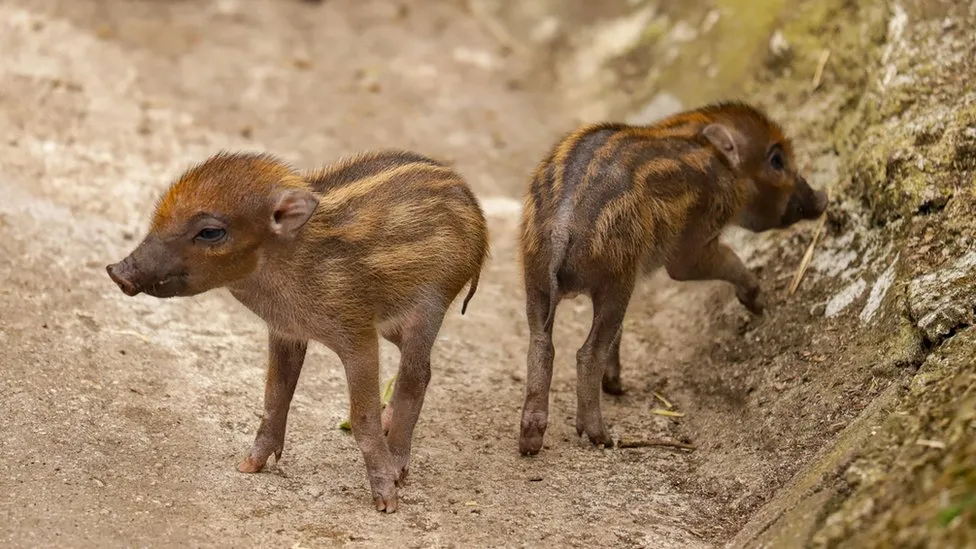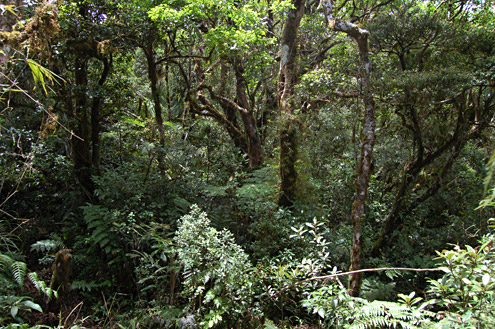Step into the Philippines and meet the endemic rockstar of the Visayas—the Visayan warty pig
With a luscious mane that can make its admirers scream, this species is undeniably born to be the superstar of the woodland scene. Unfortunately, with the rise of mass logging operations, hunting, and agricultural burning, the existence of this celebrity is threatened, leading to its endangerment. Currently, it hides in captivity and isolation for breeding and conservation—a picture not intended for a star.
Habitat and Behavior
Mr. Golden Sun truly shines down on these creatures as they are usually found in tropical or subtropical areas hence, they are in the Central Philippines. They also enjoy the shade of trees in montane or low-level forests. Commonly, they go for undisturbed areas but would sometimes make mildly disturbed areas their home, especially if there is vegetation so it would be easier for them to feed themselves. Any of these areas could be their natural habitat so they can pretty much adapt to their environment.
 |
| https://www.rappler.com/environment/hectares-land-philippines-forested/ |
Unfortunately, human activities continue to diminish their natural habitats (I hope you feel guilty, unless you’re not human). They are either caught for their meat or they live in areas where food is scarce, so in short, they have to choose between being the solution to hunger or literally joining the hunger games. It seems that part of the reason many of them are caught at the same time is because despite how scary they may look to us, they are actually social animals. They live in groups called sounders, inhabiting a specific territory they mark with their scent glands. Each sounder has a leader, usually a male (Are we even surprised?), with several females. This way, their reproductive behavior continues within the sounder. Each also has a specific role whether it be babysitters for the offsprings, food gatherers, or security guards protecting the sounder from external threats like predators. These species are omnivorous-- they feed on fruits, plants, and small insects and animals like worms or rats. Do they eat their own kind? It’s for you to find out 😉.
Moving on, they communicate with sounds like grunts and squeals so they have their own grammar apparently. The more important activities they do are done during the night and at daytime, due to the lack of sweat glands, they regulate their body temperature by wallowing in muds so yes, Peppa Pig probably learned this behavior from them.
Visayan warty pigs spread seeds through defecation and aerate the soil when digging while foraging so basically, they also lowkey work for the food they eat. How cool is that?
Threats and Conservation Status
Just like any other superstar, our rock n' roller approaches its rarity. While about 200 of them are currently taken care of in conservation grounds, their wild population seems to be unknown. Why, you ask? Well, one of the reasons why its number is hard to increase is due to the deforestation on the acres of land they have used as their habitat. As the years pass, the Philippines continues to become modernized, and that has led to deforestation, wherein hundreds of trees are cut down to convert the land into an agricultural one or for business purposes like commercial buildings or subdivisions, as well as illegal logging.
Conservation Efforts
Legal Protection
Conservation Programs
But that's not all! There are also conservation programs in place to protect the Visayan warty pig. The Visayan Warty Pig Conservation Programme (VWPCP) was established in 1992 to re-introduce the species on the islands in the Philippines where it has been lost by building rescue and breeding centers on Panay and Negros. The program conducts wide-range surveys and other field research, education awareness campaigns, assistance in the establishment of new protected areas, diverse personnel training, and other local capacity-building initiatives. The Talarak Foundation, established in 2010, also helps in the conservation of the Visayan warty pig by protecting populations of regionally endemic species through collaborations, conservation education, research, and restoration of endemic species and habitats while developing sustainable livelihoods and fostering harmony between communities and the environment. The foundation conducts field studies and sets up motion-sensing, night-vision-equipped camera traps on trees to monitor the health and population of the pigs. The results of their research are used to designate additional protected areas and spots for reintroduction in the wild.Captive Breeding and Reintroduction
Captive breeding also plays a crucial role in protecting the Visayan warty pig. Zoos like Newquay Zoo and Fundacja Zoo Wroclaw-DODO have set up programs where these pigs can thrive and reproduce in a safe environment. These zoos also offer financial support to foundations in the Philippines, helping fund ongoing research and conservation initiatives aimed at ensuring the well-being and survival of the Visayan warty pig in its natural habitat. Captive breeding serves as an insurance policy for Visayan warty pigs, especially when diseases might threaten their wild populations. The teamwork between conservation programs and captive breeding is all about making sure these pigs not only survive but thrive in their natural homes. It's a complete strategy to keep these amazing animals around for the long run.Success Stories of Conservation
Talarak Foundation advocacy for the welfare of keystone species endemic to the West Visayan faunal region
Hey Folks! I know that you have already learned a lot but be ready again with this meaningful revelation. Have you ever heard about the Talarak Foundation? Situated at Kabankalan City, it is a conservation organization that manages wildlife sanctuaries and a main captive breeding center for endangered avian species. But wait! Prepare for an unexpected plot twist. In December 2021, super typhoon Odette served as a wakeup call for the organization to refocused its efforts on other less climate-susceptible sanctuaries.Talarak Foundation is known as an instrument in advocating the welfare of the Western Visayas “big five”, which includes the Visayan Warty Pig, Rufous-headed Hornbill, the Visayan Spotted Deer, the Negros Bleeding Heart Dove, the Visayan Tarictic Hornbill, of the West Visayan faunal region that includes Panay, Negros, Masbate and Guimaras.
Enough with those challenges! Let us shift our focus into the extraordinary world of conservation success! Matthew Ward, the executive director of Talarak Foundation said that the new captive breeding and reintroduction initiatives have verified that these ways have been fruitful for the conservation efforts of the big five. This is further proved after it concentrated programmes on the Bayawan Nature Reserve wherein it is a site that spans up to 300 hectares of rich grasslands and forests in the valleys located near the city of Bayawan in Negros Occidental. Furthermore, he said that the foundation has released groups of Visayan Spotted Deer and Warty Pigs into the reserve. Those released species have produced offspring in the wild. Fernando Gutierrez, president of Talarak Foundation, also said that compared to 20 years ago, the warty pigs are doing better and will definitely bounce back if they are left alone.
Negros Forest & Ecological Foundation, Inc. Biodiversity Conservation Center (NEEFI - BCC)
Opps! The success stories have not yet ended! Now, be ready to dive into the amazing story of NEEFI - BCC. A non-stock and non-profit private organization, that protects, conserves and preserves the natural resources which includes the captive breeding and rescue of endangered species and the creation of wildlife reserves.
One of the endangered species they rescued are the Visayan warty pigs. This species is now classified as critically endangered, with its population declining by more than 95% of its previous geographic range in just a span of three generations which was caused by hunting, habitat loss and hybridization.
This rescue and breeding center has been acknowledged in the Philippines. This organization aims and allows the species, including the Visayan warty pigs, to maintain their population and continue in their remaining strongholds.
How to Help
International Scale
On an international scale, you can do strategies such as cooperating with Visayan Warty Pig Conservation Programme and Talarak Foundation. This is in support of Sustainable Development Goals (SDGs) no. 15 that “protect, restore and promote sustainable use of terrestrial ecosystems, sustainably manage forests, combat desertification, and halt and reverse land degradation and halt biodiversity loss.”
Local Scale
On a local scale, especially in the Visayan Islands, some strategies you can do include disseminate information for local awareness, integrate knowledge into educational avenues, create recovery plans, examining Republic Act No. 9147, getting involved in monitoring and evaluating current species’ status, and involve yourself in cooperating with non-government organization (NGO) for preserving the species in whatever way you can!
As these strategies will make you help the said species, the related news and events will supplement that for further information and guidance.
International Scale
On an international scale, you can do strategies such as cooperating with Visayan Warty Pig Conservation Programme and Talarak Foundation. This is in support of Sustainable Development Goals (SDGs) no. 15 that “protect, restore and promote sustainable use of terrestrial ecosystems, sustainably manage forests, combat desertification, and halt and reverse land degradation and halt biodiversity loss.”
Local Scale
Related News and Events
 |
| https://www.bbc.co.uk/news/uk-england-cornwall-65469595 |
But, to not
end this with bad news, on April 16, 2023, Newquay Zoo celebrates the birth of two
Visayan warty pigs which was less than a year after the mother gave birth to
two other piglets. Let us all hope that the conservation status of Visayan warty pigs improves overs the years!
References
Albay, R. L. (2023, April 28). Saving deers and warty pigs: A conservation organisation’s brave last stand for the West Visayan “big five” species. Eco-Business. https://www.eco-business.com/news/saving-deers-and-warty-pigs-a-conservation-organisations-brave-last-stand-for-the-west-visayan-big-five-species/
BBC (2023, May 03). Newquay Zoo celebrates birth of rare 'warty' piglets. https://www.bbc.com/news/uk-england-cornwall-65469595
Dell’Amore, C. (2022, January 25). Meet the critically endangered pig with a rockstar mohawk. Animals. https://www.nationalgeographic.com/animals/article/endangered-warty-pigs-mohawks-philippines
GMA Public Affairs (2022, August 28). Rescuing the Philippine Warty Pig | Born to be Wild. https://www.youtube.com/watch?v=RvbCGkSrxos
NOAA Fisheries (n.d.). Recovery of endangered and threatened species. https://www.fisheries.noaa.gov/insight/recovery-endangered-and-threatened-species
Robinio, B. M. (n.d.). DENR RESCUES CAPTIVE VISAYAN WARTY PIG. https://r8.denr.gov.ph/index.php/news-events/press-releases/2175-denr-rescues-captive-visayan-warty-pig
Rodriguez, A. M. (2020, August 29). Visayan warty pig. Christians in Conservation Philippines. https://www.christiansinconservation.org/endemic-species-of-ph/visayan-warty-pig/
Speciesonthebrink. (2019, October 2). Visayan Warty Pig - Asian Species Action Partnership. Asian Species Action Partnership - Species on the Brink. https://speciesonthebrink.org/species/visayan-warty-pig/
Talarak Foundation. (n.d.). Talarak Foundation. https://www.talarak.org/
United Nations. (n.d.). Goal 15 | Department of Economic and Social Affairs. United Nations. https://sdgs.un.org/goals/goal15
Visayan warty pig. Visayan Warty Pig - Facts, Diet, Habitat & Pictures on Animalia.bio. (n.d.). https://animalia.bio/visayan-warty-pig
Visayan Warty Pig - Christians in Conservation Philippines. (2020, August 29). Christians in Conservation Philippines. https://www.christiansinconservation.org/endemic-species-of-ph/visayan-warty-pig/
Visayan warty pig - sus cebifrons negrinus. Marwell Zoo. (2023, April 28). https://www.marwell.org.uk/animals/visayan-warty-pig/
Visayan Warty Pig Conservation Program - Fundacja Zoo Wrocław DODO. (2020, December 6). Fundacja Zoo Wrocław DODO. https://fundacjadodo.pl/en/project/visayan-warty-pig/
Wildlife Resources Conservation and Protection Act. (Republic Act No. 9147). (n.d.). Ecolex. https://www.ecolex.org/details/legislation/wildlife-resources-conservation-and-protection-act-republic-act-no-9147-lex-faoc041009






Comments
Post a Comment